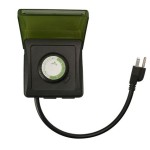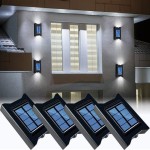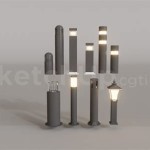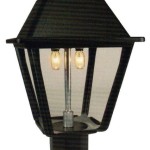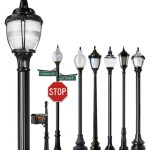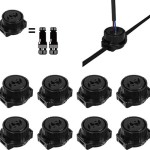How Many Lumens Is Good For Outdoor Lighting
Outdoor lighting serves a variety of purposes, from enhancing security to highlighting landscaping features and creating ambiance. Choosing the right level of brightness, measured in lumens, is crucial for achieving the desired effect without causing light pollution or wasting energy. This article explores the appropriate lumen ranges for various outdoor lighting applications.
Understanding the relationship between lumens and lighting needs is essential. Lumens measure the total amount of visible light emitted by a light source. Higher lumens indicate a brighter light. The required lumens for a specific area depend on factors like the size of the space, the desired lighting effect, and the surrounding environment.
For general walkway and pathway lighting, a range of 100-200 lumens is typically sufficient. This level of brightness provides adequate visibility for safe navigation without being overly harsh. Lower lumens can be used for pathways intended for leisurely strolls or to create a more subtle, ambient effect. Path lighting should be strategically placed to illuminate the walking surface and surrounding areas without creating glare.
Security lighting requires a higher lumen output to deter potential intruders and illuminate dark areas effectively. For floodlights and motion-sensor lights, a range of 700-1300 lumens is recommended. This level provides ample illumination to expose hidden areas and deter unwanted activity. For larger properties or areas requiring increased security, higher lumen outputs may be necessary. Careful placement and aiming are essential to avoid directing bright light towards neighboring properties.
Landscape lighting focuses on highlighting architectural features, trees, and plants. The required lumens vary depending on the size and distance of the object being illuminated and the desired effect. For smaller shrubs and plants, 50-150 lumens are usually sufficient. Larger trees or architectural details may require 200-500 lumens or more to be effectively highlighted. Accent lighting, which creates dramatic effects by focusing light on specific features, can utilize higher lumen outputs as needed. Using low-voltage LED landscape lighting helps conserve energy while providing effective illumination.
Deck and patio lighting aims to create a welcoming and functional outdoor living space. A combination of lighting types is often used to achieve the desired atmosphere. For general ambient lighting, string lights or lanterns providing 400-600 lumens can create a warm and inviting environment. Task lighting for specific areas, such as grilling stations or dining areas, may require higher lumen outputs between 700-1000 lumens to ensure adequate visibility. Dimmable lights offer flexibility in adjusting the brightness to suit different activities and moods.
Driveway lighting requires careful consideration to ensure both safety and aesthetics. Low-level bollard lights or pathway lights along the edges of the driveway, providing 100-200 lumens each, can define the driveway's boundaries while enhancing visibility. For larger driveways, strategically placed spotlights with 400-600 lumens can illuminate specific areas. Avoiding excessive brightness is crucial to prevent glare that could interfere with driving visibility.
Energy efficiency plays a significant role in outdoor lighting choices. LED (Light Emitting Diode) lights are a highly energy-efficient option compared to traditional incandescent or halogen bulbs. LEDs consume significantly less electricity while providing the same or greater lumen output, leading to long-term cost savings and reduced environmental impact. When choosing outdoor lighting, consider the efficacy rating, measured in lumens per watt (lpw), to compare the energy efficiency of different options.
Light pollution is a growing concern, impacting both the environment and human health. Minimizing light pollution involves choosing appropriate lumen levels, using shielded fixtures to direct light downwards, and utilizing motion sensors or timers to reduce unnecessary illumination. Dark sky compliant lighting fixtures are designed to minimize upward light emission and help preserve the natural nighttime environment.
Local regulations and homeowner association rules may also dictate the permissible lumen levels for outdoor lighting. It's essential to consult local guidelines before installing new outdoor lighting to ensure compliance and avoid potential issues with neighbors or local authorities. These regulations often address light trespass, which refers to light spilling onto neighboring properties, and may specify maximum lumen outputs or require shielded fixtures.
Choosing the right number of lumens for outdoor lighting requires careful consideration of the intended purpose, the size of the area being illuminated, and the desired ambiance. Prioritizing energy efficiency and minimizing light pollution are essential aspects of responsible outdoor lighting design. By understanding the principles of lumen output and following best practices, individuals can create safe, functional, and aesthetically pleasing outdoor spaces.

How Many Lumens Outdoor Landscape Lights Need To Work Well

How Many Lumens Do You Need For Outdoor Lighting

How Many Lumens Are Needed For Outdoor Lighting The Home Depot

How Many Lumens Do I Need For Outdoor Lighting 2024 Guide

How Many Lumens Do You Need For Outdoor Lighting

How Many Lumens Do You Need For Outdoor Lighting Villaneri

Led Flood Lights What You Need To Know

How Many Lumens Do I Need For Outdoor Lighting Easy Guide

How Many Lumens Are Needed For Outdoor Lighting The Home Depot
How Many Lumens Do I Need For Outdoor Lighting Quora
Related Posts
